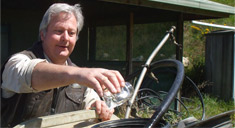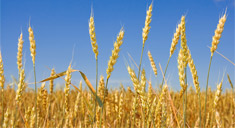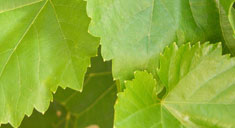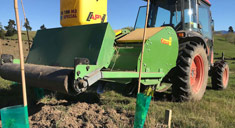Vinasse of ‘Organo-N’, Bio Gro # 433
Vinasse originates in the process of sugar refinement of sugar beet and is an organic liquid fertiliser. Sugar beet pulp is fermented to gain the left over sugar for yeast production. The remainder of that process is called vinasse. It is mainly a soil fertiliser to be used to encourage the growth of any crop in horticulture, viticulture and market gardening.
Together with any fertigation system vinasse is to be applied to a max. of 5%. In direct application to the soil it can be used at higher concentration. Vinasse has a high N and K2O content. The carbohydrate of vinasse feed the soil food web.
Advantages: N – 5%, K2O – 5,5%, CaO – 1,2%, P2O5 – 0,3%, S – 0,2%, Mg 0,02%
- N in form of amino acids and the alkaloid growth promoter Betaine (Prof. J.Delbruck).
- Highly pre-digested carbohydrates activate the production of nitrogen fixing bacteria. With their help a higher rate of nitrogen will be available to the crop.
- Production and re-formation of organic substance will increase = humus pool growth.
- Activating the soil-food web supports the formation of feeding – and stable humus and other organic soil fractions, together they provide a medium to long term fertility result, a more permanent nutrient and trace element release via fertiliser mobilisation.
- Vinasse is highly water soluble. Parts of the nitrogen are readily plant available.
- Potassium in the form of potassium sulphate makes plants more resilient and water-stress tolerant; growth is supported during low or high water periods.
- It is a valuable addition to soil fertility, nutrient mobility/availability, crop yield and quality.
- Water reserve capacity; up to 3 times of H2O/weight of micro-organisms stay in the ground.
- Vinasse is ideal to be used with irrigation and fertigation setups. At lower rates it can also be used as a foliar application. Pre-watering and several applications at low rates have proven best success.
- Vinasse co-composted has a positive effect on the physical, chemical, and biological properties of the compost and soil.
Thanks to the amino acids and the Betaine, N is organically fixed and is predominantly a slow release source of growth. The measurable N resource is increasing slowly while the noticeable increase of plant stability is caused by the foliar development. Soil and plant health effects are also resulting with this slow release nitrogen pool.
The research Institute of Wageningen university in the Netherlands reports: ‘the treatment with vinasse in autumn reduces the infection of apple black spot on the foliage drastically by breaking down the leaf litter. With the help of this effect another infection with black spot in the following season has been reduced significantly’.
The content of long chained sugar complex vinasse increases soil micro organisms and results in better rotting of straw while increasing soil fertility and stability. A direct application to the soil at a 1:1 or 1:2 dilution rate is recommended. A fertigation application, via drip-line or overhead irrigation also proves good results.
Young plants can be treated from the age of a fortnight onwards. Extra fertigation of established cultures can be applied throughout the whole life cycle.
Mycorrhiza growth is supported by Vinasse application
Mycorrhiza – the symbiosis of fungus and plant– supports plant growth and health. Fungus (Myco)and root(Rhiza)exchange nutrients, mainly P2O5 and N.
Compared to other soil fungi Mycorrhiza has no fungal enzyme to digest carbohydrate. Mycorrhiza can absorb minerals and water more efficiently from the soil and exchanges them with the plant for dissolved carbohydrate which benefits fungus and plant.
Through this symbiosis the fungus increases its mycelium and the root penetration area. Thus the plant can reach a greater subsurface to make more nutrients and water available. Especially in dry conditions and on nutrient poor soil the nitrogen and phosphorus supply is increased and plants under water stress can absorb more water.
At the same time the fungus protects the plant of pathogens by extruding antibiotic substances. Especially root pathogens in the ground and plant pests like aphid and fungal infections. The plant receives a win-win advantage through more vital growth and higher yield.


Contact Us
General enquiries welcomed. Request consultancy advice or speak to Andreas directly.
Contact Andreas

Order Online Now
Order our Farm and Plant Homeopathic and Organic & Biodynamic Viticulture & Horticulture products.
Order Online

Plant Homeopathy
Based on classical homeopathic principles, we offer advice on homeopathic treatment
Read On ...

Soil Cultivation
ESTA Soil Tests and analysis and Soil Management using the Spade Machine.
Find out more